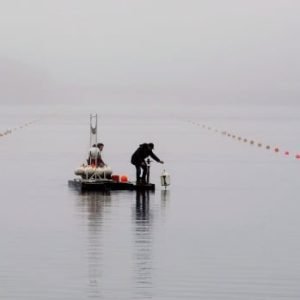
The protein in sea lettuce, a type of seaweed, is a promising complement to both meat and other current alternative protein sources. Seaweed also contains many other important nutrients, and is grown without needing to be watered, fertilized or sprayed with insecticides. However, the proteins are often tightly bound, and their full potential has not yet been realized on our plates.
But now researchers at Chalmers University of Technology, in Sweden, have found a new way to extract these proteins three times more efficiently than before—and this progress paves the way for seaweed burgers and protein smoothies from the sea.
“It tastes like umami with a certain salty flavor, despite not containing such high levels of salt. I would say it’s a great flavor enhancer for seafood dishes and products, but the possibilities to explore are endless. Why not protein smoothies or ‘blue burgers’ from the sea?” says João Trigo, Ph.D. in Food Science at Chalmers, about the dark green powder, which is a concentrate of proteins from sea lettuce, scientifically known as Ulva fenestrata.
Sea lettuce is a type of macroalgae, commonly called seaweed, which grows on rocks in calm waters, or free-floating on the surface, and resembles ordinary lettuce leaves in appearance.
The so-called protein shift—switching from red meat to more sustainable and healthy protein sources—is a way to reduce the climate impact of food production while providing everyone with a nutritious diet. Many alternative protein sources, mainly based on pea, soy and mushroom, are common in our grocery stores. But all the vegetarian protein that is found under the sea is still an untapped source.
The CirkAlg-project, led by Chalmers University of Technology, has explored the possibilities of developing processes that can create a new, “blue-green” food industry in Sweden, and make use of seaweed as a promising source of protein.
Within the framework of the project, a newly published scientific study shows a unique way of extracting proteins from sea lettuce, so that it is now possible to extract three times more protein from the seaweed than was possible with previous methods. The paper is published in the journal Food Chemistry.
“Our method is an important breakthrough, as it brings us closer to making it more affordable to extract these proteins, something that is done with pea and soy proteins today,” says João Trigo.
Contains several essential nutrients
In addition to essential proteins, sea lettuce contains several other substances of great nutritional value for humans, such as vitamin B12 and the same kind of omega-3 fatty acids found in oily fish, like salmon. People who do not eat animal products are at risk of developing a deficiency of vitamin B12, which is necessary for the body to form red blood cells, among other things.
And the cultivation of sea lettuce has several advantages compared to land-growing proteins—such as the fact that the seaweed does not need to be watered, fertilized or sprayed with insecticides. Sea lettuce is also hardy and grows well under many different conditions, such as different salinity and access to nitrogen.
“Humanity will need to find and combine the intake of many more diversified protein sources than we have available in our diet today, to meet sustainability and nutritional requirements. Algae is a good addition to many of the products already on the market. We need all these solutions and so far, the sea-based possibilities, the so-called blue proteins, have been overlooked,” says Ingrid Undeland, Professor of Food Science at Chalmers and coordinator of CirkAlg.
In addition to the newly published extraction method, the Chalmers researchers are working together with the University of Gothenburg to increase the actual protein content in the seaweed. By cultivating sea lettuce in process water from the seafood industry, the protein content can be increased significantly, while nutrients that would otherwise be lost are circulated back into the food chain.
At Tjärnö Marine Laboratory (part of the University of Gothenburg) in northern Bohuslän in Sweden, a large number of successful cultivation experiments have been carried out within the CirkAlg-project, based on industrial water side currents.
“In the future, we also want to be able to make use of the parts of the algae that are not proteins, and that could be used in food, materials or for medical applications. The goal is that no molecules should go to waste, to achieve both sustainability and commercial opportunities,” says Undeland.
More about the extraction method
In addition to proteins that are water-soluble, sea lettuce also contains plenty of fat-soluble so-called membrane proteins. This means that the seaweed proteins are more complex to extract than, for example, soy and pea protein.
In a first-step of the new process, the cell membranes of the sea lettuce are opened up in order to access the fat-soluble proteins. The different types of proteins are then extracted with water adjusted to a high pH, and in the next step, by making the solution acidic, the proteins are precipitated into aggregates that could then be separated from the water and utilized as a protein-rich ingredient.
It was also seen that the marine omega-3 fatty acids were enriched in the protein ingredient, and a follow-up study confirmed that the same was true for vitamin B12. The new algae protein ingredient can thus help meet a wider range of nutritional needs compared to soy protein.
The study’s authors are João Trigo, Sophie Steinhagen, Kristoffer Stedt, Annika Krona, Simone Verhagen, Henrik Pavia, Mehdi Abdollahi and Ingrid Undeland. At the time of the study, the researchers were active at Chalmers University of Technology, the University of Gothenburg and RISE—Research Institutes of Sweden.
More information:
João P. Trigo et al, A new method for protein extraction from sea lettuce (Ulva fenestrata) via surfactants and alkaline aqueous solutions, Food Chemistry (2024). DOI: 10.1016/j.foodchem.2024.141839
Citation:
Seaweed proteins could be the next sustainable food source (2024, November 13)
retrieved 13 November 2024
from https://phys.org/news/2024-11-blue-green-sustainable-proteins-seaweed.html
This document is subject to copyright. Apart from any fair dealing for the purpose of private study or research, no
part may be reproduced without the written permission. The content is provided for information purposes only.








